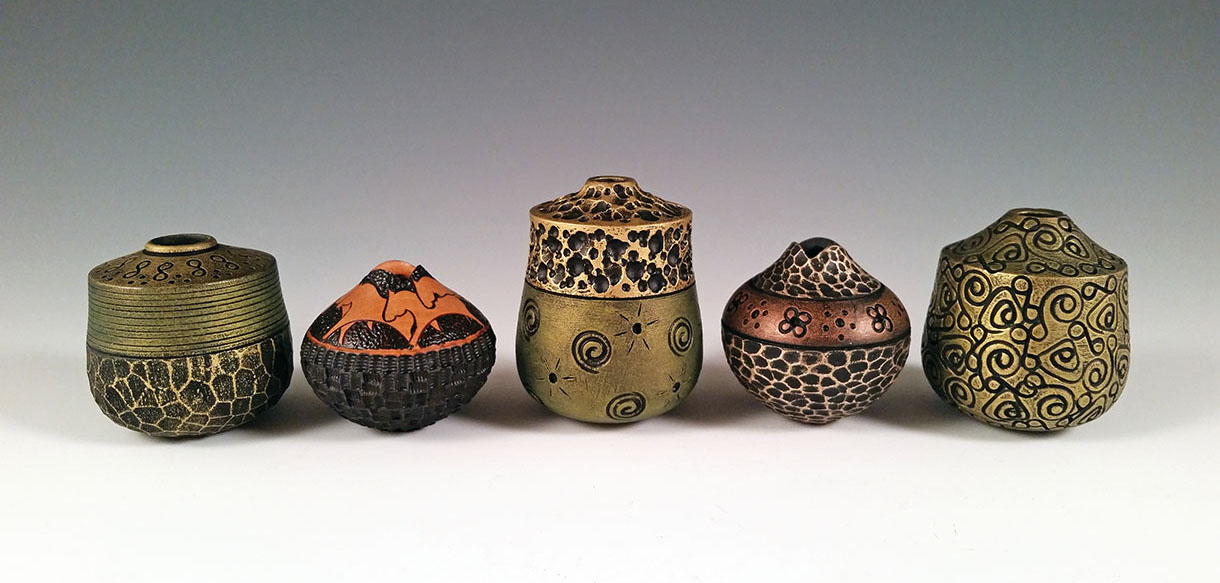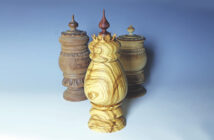Molly Goodfellow Winton – ‘Minis’:
Molly Goodfellow Winton tells us of her inspirations when making minis.

Molly Goodfellow Winton tells us of her inspirations when making minis
Minis, a speciality of maker Molly Goodfellow Winton, was inspired by ancient, and prehistoric art such as cave drawings and other ancient artefacts depicting animals and nature. Making minis was first a way of using offcuts and scraps of pretty wood, so they wouldn’t go to waste. Over time, Molly found other benefits to significantly scale down the pieces she made and always a proponent of exquisite form; minis forced her to attend to minute details to ensure the final proportions and aesthetic. She says: “there is little room for error on a 40-50mm tall vessel,” adding that minis are great experimentation by attempting unfamiliar forms or trying out new embellishment techniques. Trying out new things on a piece of wood that’s only 45mm tall is a lot easier to throw away if something goes wrong, rather something that’s four times that size.
Although this is a great way to experiment, Molly believes that carving facets and impressions into the surface simulate chiselled rock and cave walls. Molly uses ancient forms of pottery and basketry to inspire her vessel shapes and on some pieces further enhances the textures through the use of gesso and Gilders Paste. Carving, engraving, and pyrography and making small branding irons out of wire allow her to print the symbols onto the minis. Molly told us “feeling textures with my hands and exploring the same with my eyes is thrilling, and a successful piece is one that when the admirer picks it up, they don’t want to set it back down.”
Cave paintings
Cave paintings are painted drawings on cave walls or ceilings, and mainly of prehistoric origin. Although the exact purposes of cave paintings are unknown, there are theories that cave paintings may have been a way of communicating with others. Remarkably, these paintings are similar around the world with animals being common subjects, and humans mainly appear as images of hands or stick men.
The majority of prehistoric cave paintings were figurative and 99% of these were animals. During the Stone Age, predator animals were mostly painted such as lions, sabre-toothed felines and bears, almost as often as ‘game’ animals like bison, and reindeer. Pictures of humans were exceptionally rare occurrence, and were usually highly stylised and far less naturalistic than the animal figures.Abstract imagery (signs, and symbols) were also common, and actually compromises the oldest type of Palaeolithic art found in caves of the late Stone Age.
The earliest known cave paintings are at least 35,000 years old and they’ve been discovered in hundreds of caves around the world particularly France and Spain. The Lascaux caves located in southwest France are famous for its cave paintings and contain some of the best-known Upper Palaeolithic (the third and last subdivision of the Palaeolithic or Old Stone Age) art and these paintings are estimated to be around 17,300 years old. These images consist primarily of large animals, most of which are known from fossil evidence to have lived in the area at the time. The oldest cave paintings are reported to be on the Indonesian island of Sulawesi, and before then, the oldest cave painting known was a 40,800-year-old red disk from
El Castillo in Northern Spain.



